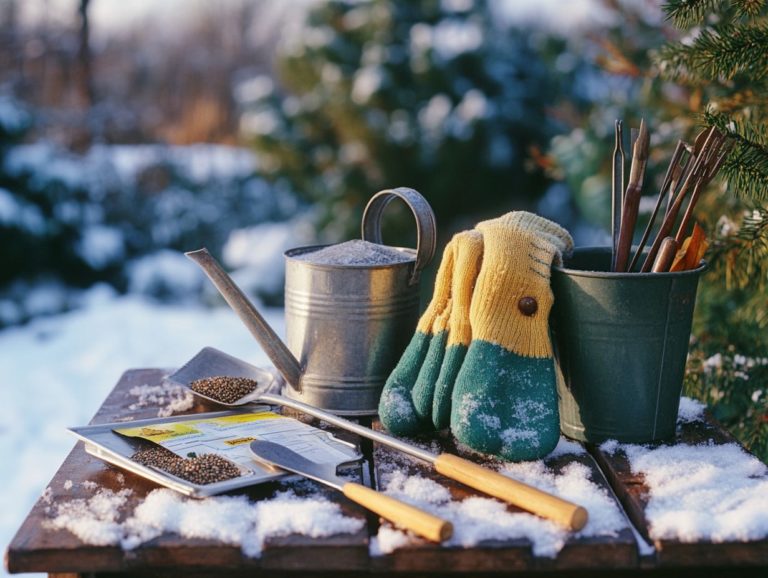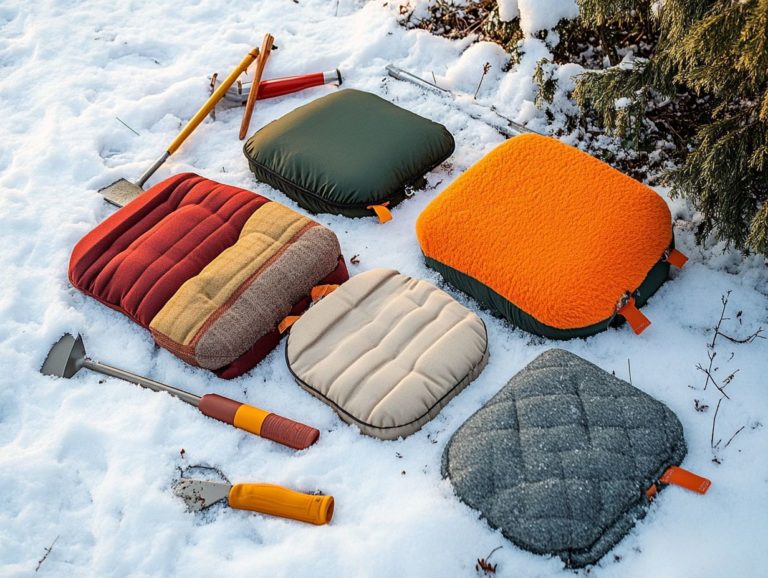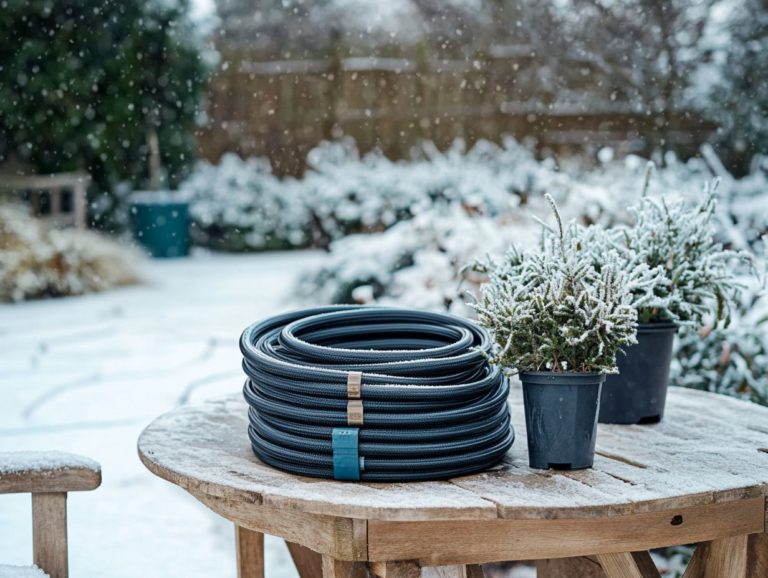Winter Pruning Tools: What You Need
Winter pruning may seem daunting at first, but with the right tools, it becomes manageable and enjoyable.
Whether you’re tackling unruly shrubs or shaping trees, knowing which pruning tools to use will elevate your gardening experience and enhance your plant’s health.
This guide explores essential pruning tools, from classic hand pruners to specialized loppers and saws. We also share maintenance tips to keep your equipment in top shape.
Get ready for a fantastic pruning season ahead!
Contents
- Key Takeaways:
- 1. Pruning Shears
- 2. Loppers
- 3. Pruning Saw
- 4. Hedge Shears
- 5. Hand Pruners
- 6. Pole Pruners
- 7. Pruning Knife
- 8. Pruning Gloves
- 9. Hand Saw
- 10. Ratchet Pruners
- 11. Grafting Knife
- 12. Pruning Saw with Telescopic Handle
- 13. Bypass Pruners
- 14. Anvil Pruners
- 15. Pruning Tool Maintenance Tips
- What Are the Different Types of Pruning Tools?
- Frequently Asked Questions
- What are some essential winter pruning tools?
- Why is it important to use the right tools for winter pruning?
- Can I use regular pruning tools for winter pruning?
- How often should I clean and maintain my winter pruning tools?
- Are there any safety precautions I should take when using winter pruning tools?
- What are some signs that my winter pruning tools need to be replaced, including tools like electric pruners and pruning shears?
Key Takeaways:
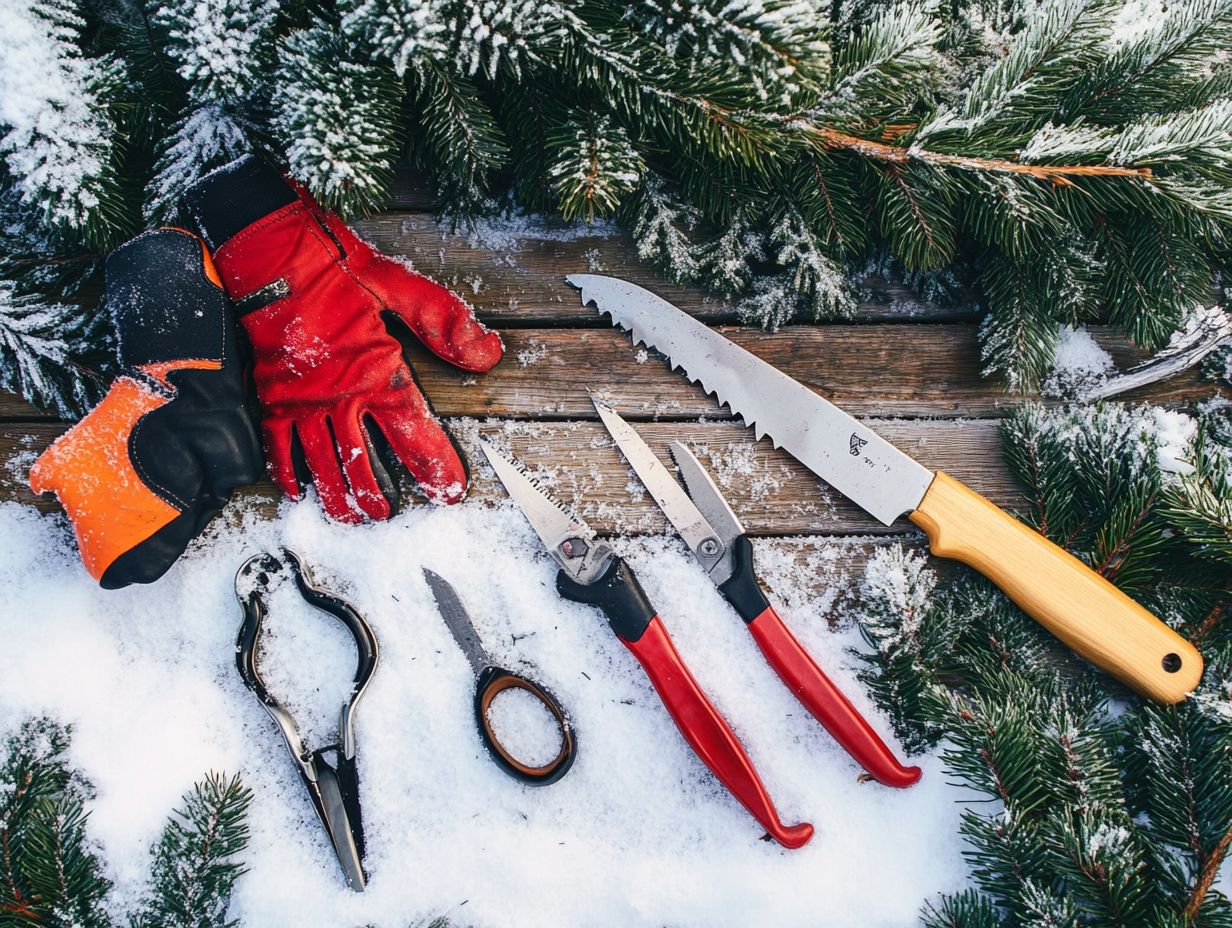
- Invest in quality tools like pruning shears, loppers, and pruning saws for effective plant care this winter.
- Consider the specific needs of your plants and your gardening space when choosing between different types of pruners.
- Maintain your tools properly by cleaning and sharpening them regularly. Store them in a dry place to ensure longevity.
1. Pruning Shears
Pruning shears are indispensable garden tools that help promote healthy plant growth. These reliable companions are perfect for various pruning tasks, whether you’re aiming for a neat appearance or boosting fruit production.
You’ll find different types available, such as scissor-like pruners that make clean cuts on delicate stems. These tools are vital for trimming branches and managing hedges, enhancing your pruning efficiency and ensuring your plants thrive.
For thicker branches, anvil pruners are a great choice. They have one blade that pushes down onto a flat base, making them effective for tougher jobs. If you need a bit more power, ratchet pruners allow for multiple cutting motions, making heavy pruning much easier.
When choosing your shears, think about the branch thickness you’ll encounter. Scissor-like pruners are best for stems up to half an inch, while anvil pruners can easily handle an inch or more. Regular maintenance is key to longevity; keep the blades sharp with honing tools and lubricate the pivot point for smooth operation.
2. Loppers
Loppers are essential gardening tools designed for cutting thicker branches and stems. They feature an ergonomic design that extends your reach and boosts cutting power without straining your hands.
These tools outperform standard hand pruners, especially in gardens where branch thickness varies. Their long handles provide the leverage needed to slice through branches up to two inches thick, making them versatile for all your pruning needs.
When selecting loppers, consider your gardening requirements. Pay attention to the diameter of branches and your comfort. Opt for models with cushioned grips to minimize fatigue during longer sessions, improving your overall gardening experience.
3. Pruning Saw
A pruning saw is a must-have tool for tackling larger branches that hand pruners or loppers can t handle. With a pruning saw, you can achieve clean cuts that foster healthy growth in your garden.
When selecting a saw, you ll choose between folding and fixed blade options. Folding saws are compact and easy to carry, ideal for gardeners on the go. In contrast, fixed blade saws offer greater stability and cutting power for tougher jobs.
Using proper techniques is crucial with these tools. A steady hand and controlled pressure ensure efficient cuts, preventing damage to the branch or surrounding plants. Wearing protective gear like gloves and goggles enhances safety and allows you to focus on nurturing your green sanctuary.
In conclusion, having the right pruning tools is vital for maintaining your garden effectively. Equip yourself with quality tools, and you’ll feel more confident as you tackle your pruning tasks.
4. Hedge Shears
Hedge shears are important tools in your gardening arsenal. They are designed to shape and maintain hedges, helping your landscaped areas look neat and tidy.
Different types of hedge shears meet various gardening needs. For instance, scissors-like bypass shears are great for cutting live plants, while anvil shears, which have a straight blade that closes against a flat surface, are perfect for thicker or dry branches.
You ll appreciate features like cushioned grips and lightweight designs! These make them user-friendly and easy to handle.
When using hedge shears, hold them at an angle for a natural cutting position. Seasonal pruning is crucial for keeping your hedges healthy. By pruning in early spring or late fall, you can encourage growth while controlling the shape of your plants.
5. Hand Pruners
Hand pruners, often called pruning shears, are essential tools that allow you to make precise cuts on small branches and stems. They are a must-have for maintaining effective pruning and tree care.
Understanding the different types of hand pruners can significantly improve your gardening skills.
- Bypass pruners are ideal for live plants, providing clean cuts that help them heal quickly.
- Anvil pruners are better for dead or thicker branches where precision isn’t as critical.
Choosing the right pruner depends on your technique and the specific plants you re working with. Whether shaping a succulent or trimming a woody shrub, using the right tool can lead to healthier plants and a more efficient gardening experience.
6. Pole Pruners

Pole pruners are your go-to garden tools for reaching high branches without a ladder. They offer a practical solution for effective tree care, allowing you to tackle jobs that might otherwise be out of reach.
These tools often have adjustable handles, which let you change the length based on your needs. Many models use bypass blades or anvil-style cutters, ensuring you achieve clean cuts that keep your trees healthy.
This design helps you stay safe while you work, making your pruning tasks easier and more efficient.
To use them safely, familiarize yourself with the tool’s operation. Remember to wear protective gear and maintain a steady stance to achieve precision while pruning.
7. Pruning Knife
A pruning knife is a critical tool in your gardening toolkit. It provides the versatility you need for various pruning tasks, allowing you to make detailed trims and precise cuts on branches that require careful handling.
You ll find different types of pruning knives tailored to specific needs. A straight-edged knife is perfect for clean cuts, while a curved blade is great for maneuvering around stems. A folding pruning knife offers safety and portability, making it a popular choice among gardeners.
Each style serves a unique purpose, whether removing dead wood or shaping live plants. To keep your pruning knife effective, keep the blade sharp and free of debris. Regular honing and occasional oiling will prolong its life, ensuring it remains a reliable companion for your gardening tasks.
8. Pruning Gloves
Pruning gloves are a critical component of your pruning safety gear. They offer protection against thorns and sharp branches while ensuring comfort and dexterity for effective handling of various pruning tools.
Selecting the right pair is essential for your safety and enhancing your efficiency during gardening tasks. Quality pruning gloves should be crafted from durable materials like leather or synthetic fibers, providing resilience and flexibility. Look for a design that fits comfortably and allows easy movement; this can significantly reduce hand fatigue, enabling you to work longer without discomfort.
When choosing gloves, consider the plants you’re pruning. Finer gloves are perfect for delicate flowers, while tougher options are better for wild brambles and rose bushes. This thoughtful selection process elevates your pruning experience, making it both safe and enjoyable.
9. Hand Saw
A hand saw is a critical tool for you as a gardener. It s especially useful for tackling larger branches that standard pruning shears simply can t handle. It’s an essential addition to your gardening toolkit for effective pruning maintenance.
These saws come in various designs and functionalities. For instance, crosscut saws excel at slicing through wood fibers, while pruning saws are crafted for overhead cuts, making your job easier. Many feature curved blades for improved maneuverability, and some even have replaceable blades for added convenience.
To use a hand saw effectively, employ steady, fluid strokes to minimize damage to the plant. Complement your efforts with pruning scissors for smaller cuts.
To ensure the longevity of your hand saw, regular cleaning and sharpening of the blade are crucial. Store it in a dry area to prevent rust. This maintenance boosts performance and guarantees that your tool remains reliable during your gardening tasks.
10. Ratchet Pruners
Ratchet pruners are a game-changer in the garden tool world. They have a unique mechanism that allows you to slice effortlessly through thicker branches. If you re looking for ergonomic solutions for efficient pruning, these tools are a fantastic choice!
Unlike traditional hand pruners that require constant pressure to make a cut, ratchet pruners utilize a clever ratcheting action. This means you can gradually cut through tougher materials with just a squeeze of the handles. The result? Reduced hand fatigue and enhanced precision during your pruning tasks.
When selecting the perfect ratchet pruner, pay attention to the size of your hands and the thickness of the branches you usually tackle. Choose a model that feels comfortable in your grip and provides stability. For peak performance, use a technique that involves multiple squeezes for larger branches to ensure each cut is clean and effective.
11. Grafting Knife
A grafting knife is a critical tool in your gardening arsenal. It s specifically designed for making precise cuts during grafting processes. This tool gives you the power to propagate plants effectively and maintain the health of your trees through expert pruning.
With its curved blade, the grafting knife ensures clean, accurate cuts, essential for the successful fusion of plant tissues. The tapered tip is particularly useful for detailed tasks, such as creating slits in the bark or removing unwanted foliage carefully. When using a grafting knife, start with sharp, clean cuts. This encourages healing and reduces the risk of infection.
Regular upkeep like polishing the blade and keeping it free from sap is crucial for ensuring its longevity and peak performance. Don’t wait! This diligence gives you the best opportunity to achieve your desired graft outcomes, enhancing your horticultural endeavors.
12. Pruning Saw with Telescopic Handle
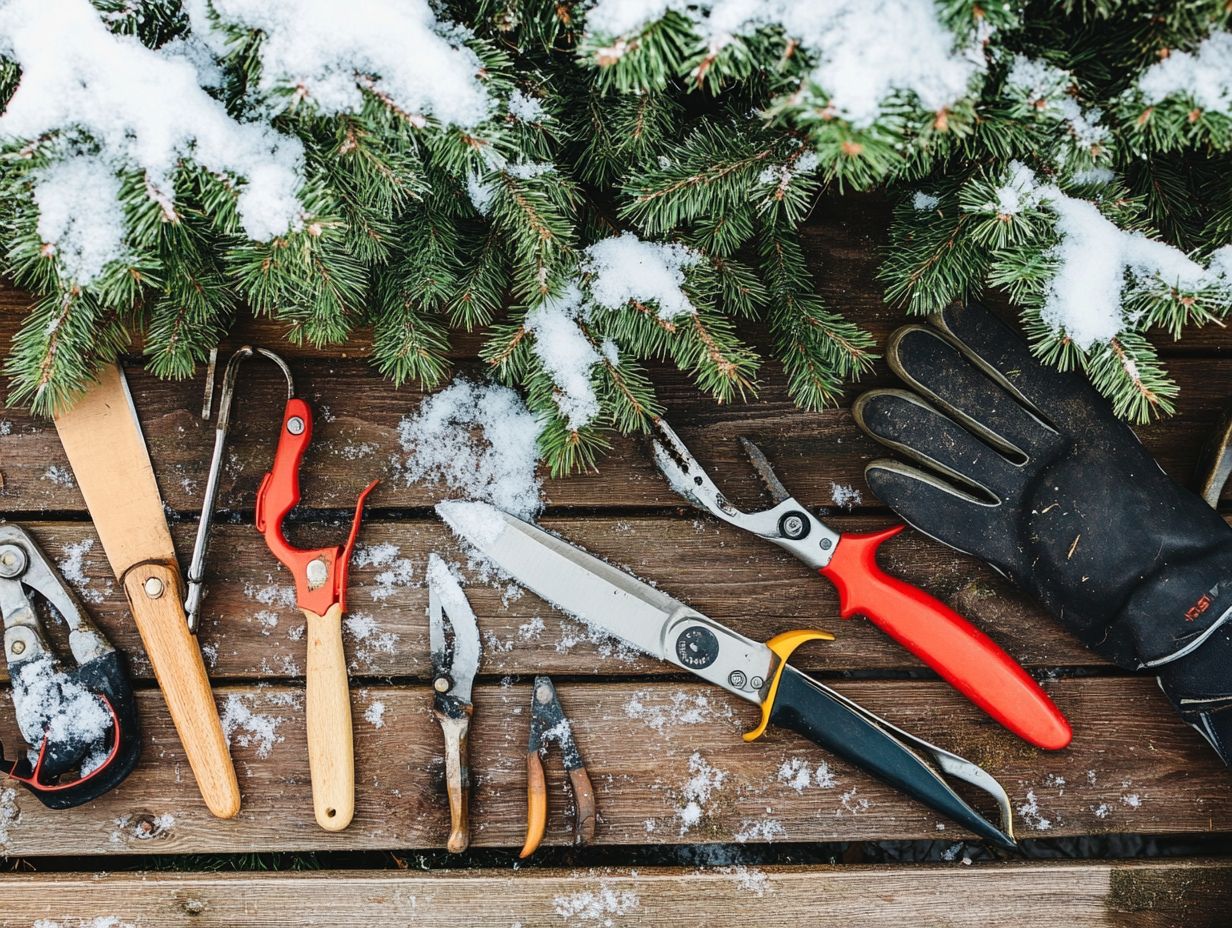
A pruning saw with a telescopic handle is a vital tool for gardeners. It enables efficient cutting of high branches without the hassle of ladders. This not only enhances your pruning safety but also boosts effectiveness in all your pruning tasks.
This feature significantly expands your reach and eliminates the risks of falls associated with climbing. Unlike standard pruning saws, these telescopic saws can change length, making them incredibly versatile for tackling branches of different heights and types.
When you use such tools, it’s important to maintain a stable stance and ensure the saw’s blade is sharp to prevent unnecessary strain. Using the right cutting technique can make a big difference start with gentle strokes and gradually increase pressure. You can achieve cleaner cuts while maximizing both safety and efficiency.
13. Bypass Pruners
Bypass pruners are key garden tools designed for making clean cuts on soft and live stems. They foster healthy growth and effective pruning maintenance in both ornamental and fruit-bearing plants.
Unlike their anvil-style counterparts that often crush stems, bypass pruners boast two sharp blades that elegantly glide past each other. This design guarantees a precise cut, minimizing damage to the plant tissue and promoting quicker healing leading to stronger, more vibrant plants.
Moreover, the ergonomic handles provide a comfortable grip, allowing you to tackle long pruning sessions without feeling fatigued. Clean off any sap or debris after use to help prevent rusting, ensuring that these pruners remain effective and reliable for years to come. Regularly sharpening the blades is essential for maintaining peak condition.
14. Anvil Pruners
Anvil pruners are your go-to garden tools, expertly designed to slice through tougher and thicker stems. They offer you a dependable partner for efficient pruning and effective cutting.
These tools feature a sharp blade that works against a flat surface known as the anvil. This makes them exceptionally suited for snipping away dead or dry branches, as well as tackling more resilient plants. Unlike bypass pruners, which use two sharp blades for slicing, anvil pruners apply a slight crushing action to the stem. This can be particularly advantageous when dealing with woody stems.
When selecting the ideal anvil pruner for your gardening needs, consider the size and strength of your hands and the types of plants that need pruning. Opting for pruners with a larger cutting capacity can make managing thicker branches a breeze, ensuring that your pruning process remains both comfortable and efficient.
15. Pruning Tool Maintenance Tips
Proper maintenance of your pruning tools is crucial for ensuring their longevity and effectiveness. Well-maintained tools not only enhance your pruning efficiency but also improve safety during all your gardening tasks, from seasonal chores to ongoing pruning.
To achieve optimal performance, make it a habit to clean your tools after each use. Removing debris and sap can prevent rust and pitting. Oiling the hinges and blades creates a protective barrier against corrosion, ensuring smooth operation. Regularly sharpening the blades of tools like shears and loppers will also improve precision and reduce the physical effort needed. This makes your gardening tasks much less labor-intensive.
Don t wait until it’s too late regular maintenance keeps your tools performing their best! Investing in high-quality tools can significantly reduce your maintenance workload, allowing you to concentrate less on upkeep and more on nurturing your plants effectively.
What Are the Different Types of Pruning Tools?
Discover the exciting variety of pruning tools that can transform your gardening experience! You ll find a variety of pruning tools available for gardeners. Each tool is crafted to meet specific needs and techniques.
Knowing the right tool is crucial for best results. Hand pruners work well for small branches and precise cuts. Loppers are long-handled pruners designed for thicker branches, while pruning saws are essential for larger limbs. Telescoping pruners can be extended to reach high branches with ease.
Understanding the type of plant and its growth habits can greatly aid your tool selection. Woody plants often need stronger tools, while softer stems are better suited for delicate shears.
Consider the ergonomic design and weight of your tools to maintain comfort during extended use. Your gardening endeavors will be all the more enjoyable when you re equipped with the right tools tailored to your needs.
Frequently Asked Questions
What are some essential winter pruning tools?
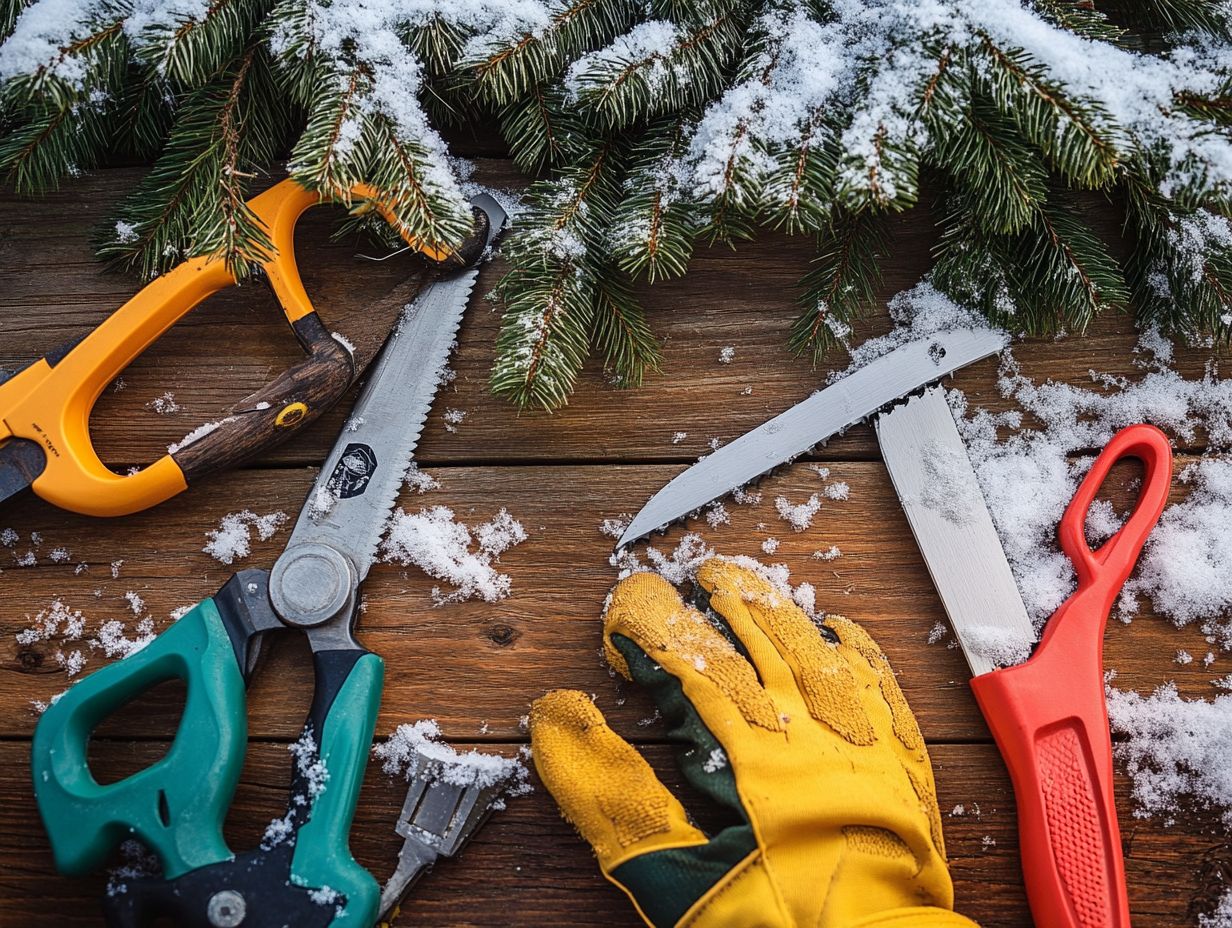
Some essential winter pruning tools include hand pruners, loppers, pruning saws, and hedge shears. These tools are designed specifically for cutting back and shaping plants during the winter months.
Why is it important to use the right tools for winter pruning?
Using the right tools for winter pruning ensures that the plants are properly pruned without causing any damage. The right tools also make the pruning process more efficient and effective.
Can I use regular pruning tools for winter pruning?
No, regular pruning tools may not be suitable for winter pruning. Winter pruning tools are designed with longer handles and sharper blades to handle tougher branches and withstand colder temperatures.
How often should I clean and maintain my winter pruning tools?
It is recommended to clean and maintain your winter pruning tools after each use. This ensures they remain sharp and in good working condition, preventing the spread of plant diseases between plants.
Are there any safety precautions I should take when using winter pruning tools?
Yes, it is important to always wear protective gear such as gloves and eye protection when using winter pruning tools. Be aware of your surroundings and avoid any electrical wires or other hazards while pruning.
What are some signs that my winter pruning tools need to be replaced, including tools like electric pruners and pruning shears?
If your winter pruning tools are no longer cutting cleanly or are starting to rust, it may be time to replace them. Dull or damaged blades can make pruning more difficult and can also harm the plants you are working on.
Ready to tackle your garden? Grab the right tools today for a thriving landscape!



